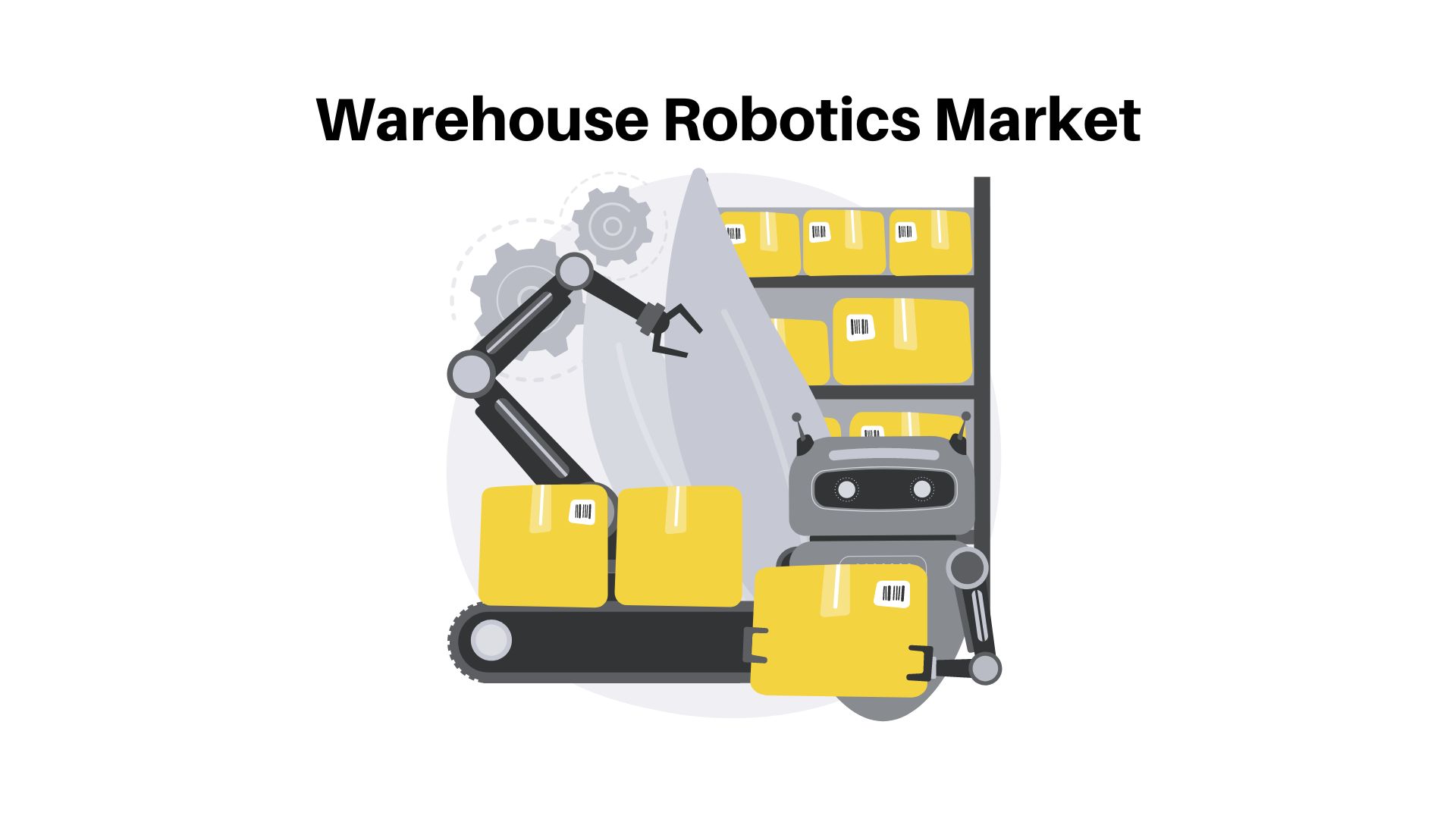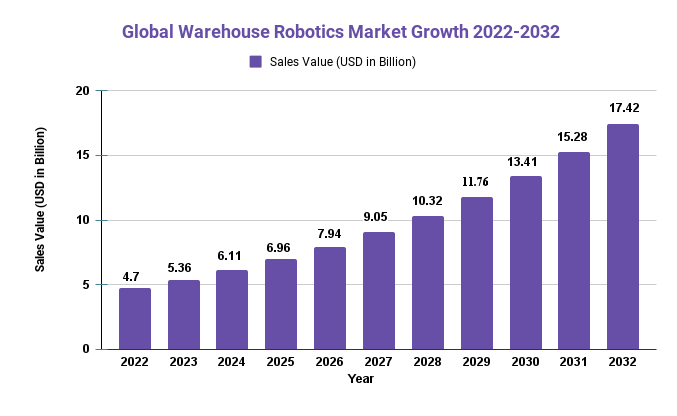Warehouse Robotics Market to Offer Numerous Opportunities, Growing at A CAGR of 14% through 2032

Page Contents
Warehouse Robotics Market Overview
Published Via 11Press: The warehouse robotics market is an expanse of automated solutions designed to enhance efficiency and productivity in warehouse operations. Common robotics tools include robots, automated guided vehicles (AGVs), autonomous mobile robots (AMRs), as well as automated storage and retrieval systems (AS/RS). These devices find use in various warehouse applications like material handling, order picking, sorting, and packaging.
The warehouse robotics market is driven by several factors, such as the need for faster and more precise warehouse operations, rising demand for e-commerce and omnichannel retailing, and the growing adoption of automation technologies in logistics. Furthermore, advanced technologies like artificial intelligence (AI) and the Internet of Things (IoT) are having an impact on this space, enabling robots to work autonomously or collaborate with humans.
The global warehouse robotics market size is forecast to reach USD 17.42 billion by 2032 from USD 4.70 billion in 2022, rising at a compound annual growth rate (CAGR) of 14.00% during the forecast period.
The warehouse robotics market is segmented based on type, application, end-use industry, and region. On the basis of type, it includes mobile robots, articulated robots, collaborative robots, and more; while by application the market is divided into transportation, packaging assembly, and other uses. Finally, by end-use industry, the market can be divided into e-commerce, automotive food & beverage healthcare services among others.
The warehouse robotics market is expected to expand at an impressive rate over the coming years, driven by rising demand for automation and faster warehouse operations. Furthermore, advanced technologies such as AI, IoT, and cloud computing will further propel this growth pattern. Asia-Pacific region is anticipated to experience rapid expansion in this sector due to the growing adoption of automation technologies within logistics operations there.
Request For Sample Report: https://market.us/report/warehouse-robotics-market/request-sample/

Key Takeaways
- Rising Demand for Automation: The growing need for faster and more efficient warehouse operations has driven the adoption of warehouse robotics solutions. These programs simplify material handling, order picking, and packaging processes – leading to improved productivity levels and reduced costs.
- Growth of E-commerce and Omnichannel Retailing: As online shopping becomes increasingly popular, warehouse robotics solutions are being sought to meet the demands of these shoppers by providing faster order processing and delivery. These innovations allow companies to better meet customer demands for product availability as well as reduce shipping costs for consumers.
- Development of Advanced Technologies: The development of modern technologies such as AI, IoT, and cloud computing is enabling warehouse robots to work more efficiently and productively. This has resulted in the invention of novel warehouse robotics solutions that can perform complex tasks while collaborating with humans.
- Adoption of mobile robots: Mobile robots such as AGVs and AMRs are becoming more commonplace in warehouse robotics markets. These autonomous vehicles can navigate through warehouses on their own, eliminating the need for fixed infrastructure like conveyors and storage racks.
- Growth Prospects in the Asia-Pacific Region: The Asia-Pacific region is expected to experience rapid growth in warehouse robotics due to the increasing adoption of automation technologies within its logistics industry. This trend can be attributed to its large population, growing economy, and rising demand for goods and services in the region.
Regional Snapshot
- The warehouse robotics market is divided geographically into North America, Europe, Asia-Pacific, Latin America, and the Middle East and Africa.
- North America is the leading market for warehouse robotics, driven by increased automation within the region's logistics industry. Notable companies such as Amazon Robotics and Kiva Systems are fueling this growth in North America.
- Europe is a key market for warehouse robotics, driven by the increasing adoption of automation technologies across manufacturing and logistics businesses. Additionally, the increasing focus on improving supply chain efficiency and cutting operational costs are further fueling growth within this region.
- The Asia-Pacific region is expected to experience the fastest growth in warehouse robotics, due to the increasing adoption of automation technologies within the region's logistics industry. Furthermore, Asia-Pacific's large population, developing economy, and increasing demand for goods and services are all driving this growth within this region.
- Latin America and the Middle East and Africa are expected to witness significant growth in the warehouse robotics market, due to the rising demand for automation technologies in these regions' logistics industries. Furthermore, efforts are being made to enhance supply chain efficiency and cut operational costs in these regions; however, the adoption of warehouse robotics there is still relatively early and the market size compared to North America, Europe, and Asia-Pacific remains small.
Drivers
- Warehouse Robotics Solutions to Facilitate Faster and Efficient Warehouse Operations: With an ever-increasing demand for faster order processing and delivery, warehouses are under immense pressure to streamline their operations. Warehouse robotics can help achieve this by automating material handling, order picking, and packaging processes – thus reducing errors and increasing productivity.
- Growth of E-Commerce and Omnichannel Retailing: With the expansion of e-commerce and omnichannel retailing, warehouses must be able to process more orders quickly and accurately. Warehouse robotics solutions can assist in meeting this demand by providing faster order processing and delivery.
- Lack of Skilled Labor: In many countries, there is a severe shortage of skilled labor. Warehouse robotics solutions provide an innovative solution to address this problem by automating repetitive and laborious tasks so warehouses can reduce their reliance on human workers and boost productivity levels.
- Technological Advancements: Recent advances in robotics technology, such as artificial intelligence, machine learning, and computer vision, are making it possible to design robots that can perform complex tasks and collaborate with humans. This has spurred the creation of new and creative warehouse robotics solutions designed to enhance warehouse operations.
- Cost Savings: Warehouse robotics solutions can help to reduce operational expenses by improving productivity and eliminating errors. This has driven the adoption of warehouse robotics solutions, particularly among larger warehouses that need to process a high volume of orders.
Restraints
- High Upfront Costs: Warehouse robotics solutions require a substantial financial investment, especially for larger warehouses that need multiple robots. This may prove an obstacle to adoption for smaller operations with limited funds.
- Lack of Flexibility: Warehouse robotics solutions are usually tailored to specific tasks and may not be able to adapt to shifting demands or new product lines. This could present a problem for warehouses that require flexibility in their operations.
- Safety Concerns: Warehouse robotics solutions must be designed and operated safely to prevent accidents or injuries. This necessitates meticulous planning and investment in safety measures, which may be a deterrent for some warehouses.
- Integration with Existing Systems: Integrating warehouse robotics solutions with existing warehouse management systems and other technologies can be a complex and time-consuming task, which may pose an obstacle to adoption – particularly for warehouses with legacy systems.
- Warehouse Robotics Applications: Warehouse robotics solutions are best suited to repetitive and laborious tasks like material handling and order picking. As such, their applications may be limited in certain warehouses – particularly those requiring more specialized work or handling a wide variety of products.
Opportunities
- Growing Demand for Autonomous Mobile Robots (AMRs): Autonomous mobile robots (AMRs) are becoming more and more commonplace in warehouse robotics due to their flexibility and adaptability. This presents an opportunity for companies that specialize in developing AMRs, especially as the technology evolves further ahead.
- Expansion into New Markets: The warehouse robotics market is still relatively young, and there is immense potential for growth in emerging regions like Asia-Pacific and Latin America.
- Customized Solutions: There is an increasing demand for customized warehouse robotics solutions that are tailored to each warehouse's individual requirements. This presents an opportunity for companies that specialize in developing tailored solutions, particularly those tailored for warehouses with unique requirements.
- Collaboration with Other Technologies: Warehouse robotics solutions can be integrated with other technologies, like drones and IoT sensors, to enhance warehouse operations. This presents an opportunity for companies that specialize in developing integrated solutions.
- Advances in AI and machine learning: Technological advances are propelling the development of more sophisticated warehouse robotic solutions that can perform complex tasks and learn from their interactions with humans. This presents an opportunity for companies that specialize in creating advanced robotic technologies.
Challenges
- Growing Demand for Autonomous Mobile Robots (AMRs): Autonomous mobile robots (AMRs) are becoming more and more commonplace in warehouse robotics due to their flexibility and adaptability. This presents an opportunity for companies that specialize in developing AMRs, especially as the technology evolves further ahead.
- Expansion into New Markets: The warehouse robotics market is still relatively young, and there is immense potential for growth in emerging regions like Asia-Pacific and Latin America.
- Customized Solutions: There is an increasing demand for customized warehouse robotics solutions that are tailored to each warehouse's individual requirements. This presents an opportunity for companies that specialize in developing tailored solutions, particularly those tailored for warehouses with unique requirements.
- Collaboration with Other Technologies: Warehouse robotics solutions can be integrated with other technologies, like drones and IoT sensors, to enhance warehouse operations. This presents an opportunity for companies that specialize in developing integrated solutions.
- Advances in AI and machine learning: Technological advances are propelling the development of more sophisticated warehouse robotic solutions that can perform complex tasks and learn from their interactions with humans. This presents an opportunity for companies that specialize in creating advanced robotic technologies.
Grow your profit margin with Market.us Get this Report
Recent Developments
- Increased Adoption of Autonomous Mobile Robots: Autonomous mobile robots (AMRs) are becoming more and more commonplace in warehouse robotics due to their flexibility and adaptability. Companies such as Boston Dynamics, GreyOrange, and Locus Robotics have seen a corresponding spike in demand for their AMR solutions.
- Partnership and Acquisition Activity: There has been an impressive amount of partnership and acquisition activity in the warehouse robotics market. For instance, Swisslog joined forces with Fetch Robots in 2021 to offer autonomous mobile robots for warehouse automation, while Honeywell acquired Intelligrated, another robotics startup.
- Expansion into New Markets: Many warehouse robotics companies are expanding into new markets, particularly Asia-Pacific and Latin America. For instance, Boston Dynamics announced plans to expand its operations in 2021 and GreyOrange opened a new headquarters in Tokyo, Japan in 2022.
- Advances in AI and machine learning: Technological advances are propelling the development of more sophisticated warehouse robotics solutions. For instance, Vecna Robotics plans to release an AI-powered pallet jack by 2021 that can learn from its interactions with humans.
- Emphasis on Safety: In the warehouse robotics market, there is an increasing focus on safety. Companies are investing in new safety features and certifications; for instance, Waypoint Robotics received certification for its AMR safety system from TUV Rheinland in 2021.
Key Market Segments
Type
- Mobile Robotics
- Fixed Robotics
Application
- Automotive
- Electronics
- Food & Beverages
- Pharmaceutical
Key Market Players
- Daifuku
- Kuka
- Knapp
- Dematic
- Grenzebach
- Bastian
- Amazon Robotics
- CIM Corp
- Adept Technology
- Vanderlande
- Hitachi
- Vecna
Nature Insights
- Collaboration is Essential: Collaboration among warehouse robotics companies, warehouse management systems providers, and other technology firms is paramount to the success of the industry. In order for warehouse robotics solutions to work seamlessly together with other systems and provide a complete and effective solution for warehouse automation, collaboration must take place between all parties involved.
- Customization Is Essential: Customization is becoming increasingly critical in the warehouse robotics market, as warehouses have specific needs and constraints. Companies that can offer tailored solutions are likely to gain an edge in this competitive arena.
- Safety is Key: Safety is of the utmost importance in warehouse robotics, as these solutions often work close to people and could potentially cause injury. Companies that prioritize safety in their designs and operations will likely have an edge in this market.
- Flexibility is Essential: The warehouse robotics market is rapidly developing, necessitating companies to be able to adjust according to shifting customer needs and technological advancements. Solutions that are adaptable and versatile may have an edge in this competitive space.
- Talent is in high demand: The creation and deployment of warehouse robotics solutions necessitate specialized expertise, such as robotics engineering, AI, and machine learning. Companies that can attract and retain talented workers will likely have an edge in this market.
Report Scope
| Report Attribute | Details |
| The market size value in 2022 | USD 4.70 Bn |
| Revenue forecast by 2032 | USD 17.42 Bn |
| Growth Rate | CAGR Of 14% |
| Regions Covered | North America, Europe, Asia Pacific, Latin America, and Middle East & Africa, and the Rest of the World |
| Historical Years | 2017-2022 |
| Base Year | 2022 |
| Estimated Year | 2023 |
| Short-Term Projection Year | 2028 |
| Long-Term Projected Year | 2032 |
Contact us
Contact Person: Mr. Lawrence John
Market.us (Powered By Prudour Pvt. Ltd.)
Tel: +1 718 618 4351
Send Email: [email protected]
FAQ.
Warehouse robotics refers to the use of automated machines and systems to carry out tasks traditionally handled by human workers in warehouses and distribution centers. These may include autonomous mobile robots, automated storage/retrieval systems, as well as robotic arms.
Warehouse robotics can offer numerous advantages, such as increased efficiency, better accuracy, and reduced labor costs. Furthermore, they help reduce injury risks in the workplace while increasing safety measures.
Some examples include Boston Dynamics, GreyOrange, KUKA AG, Locus Robotics, and Swisslog.
Some potential obstacles in this space include regulatory restrictions, competition from traditional materials handling solutions, integration with existing systems, limited expertise, and high maintenance costs.
The warehouse robotics market is expected to experience steady growth over the coming years, driven by increasing demand for automation and advancements in robotics solutions. Furthermore, we may witness more collaboration and partnership activity between warehouse robotics companies and other technology providers.
The team behind market.us, marketresearch.biz, market.biz and more. Our purpose is to keep our customers ahead of the game with regard to the markets. They may fluctuate up or down, but we will help you to stay ahead of the curve in these market fluctuations. Our consistent growth and ability to deliver in-depth analyses and market insight has engaged genuine market players. They have faith in us to offer the data and information they require to make balanced and decisive marketing decisions.


